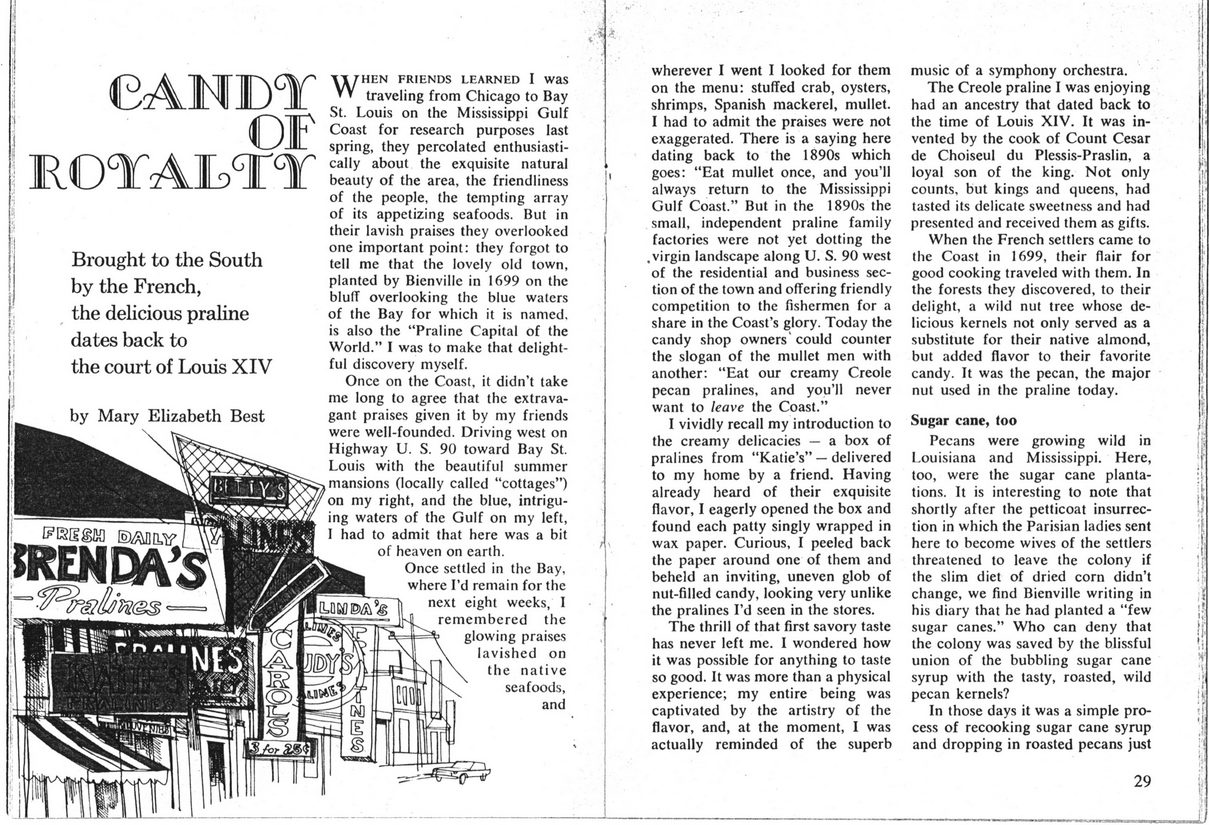This text was obtained via automated optical character recognition.
It has not been edited and may therefore contain several errors.
ROTAIdTT Brought to the South by the French, the delicious praline dates back to the court of Louis XIV by Mary Elizabeth Best e AMDT i b™ ^ St. Louis on the Mississippi Gulf d ) IH C°ast f°r research purposes last ™—/JIL spring, they percolated enthusiasti- cally about the exquisite natural beauty of the area, the friendliness of the people, the tempting array of its appetizing seafoods. But in their lavish praises they overlooked one important point: they forgot to tell me that the lovely old town, planted by Bienville in 1699 on the bluff overlooking the blue waters of the Bay for which it is named, is also the “Praline Capital of the World.” I was to make that delightful discovery myself. Once on the Coast, it didn’t take me long to agree that the extravagant praises given it by my friends were well-founded. Driving west on Highway U. S. 90 toward Bay St. Louis with the beautiful summer mansions (locally called “cottages”) on my right, and the blue, intriguing waters of the Gulf on my left, I had to admit that here was a bit of heaven on earth. Once settled in the Bay, where I’d remain for the next eight weeks, I remembered the glowing praises lavished on the native seafoods, and wherever I went I looked for them on the menu: stuffed crab, oysters, shrimps, Spanish mackerel, mullet. I had to admit the praises were not exaggerated. There is a saying here dating back to the 1890s which goes: “Eat mullet once, and you’ll always return to the Mississippi Gulf Coast.” But in the 1890s the small, independent praline family factories were not yet dotting the .virgin landscape along U. S. 90 west of the residential and business section of the town and offering friendly competition to the fishermen for a share in the Coast’s glory. Today the candy shop owners'could counter the slogan of the mullet men with another: “Eat our creamy Creole pecan pralines, and you’ll never want to leave the Coast.” I vividly recall my introduction to the creamy delicacies — a box of pralines from “Katie’s” — delivered to my home by a friend. Having already heard of their exquisite flavor, I eagerly opened the box and found each patty singly wrapped in wax paper. Curious, I peeled back the paper around one of them and beheld an inviting, uneven glob of nut-filled candy, looking very unlike the pralines I’d seen in the stores. The thrill of that first savory taste has never left me. I wondered how it was possible for anything to taste so good. It was more than a physical experience; my entire being was captivated by the artistry of the flavor, and, at the moment, I was actually reminded of the superb music of a symphony orchestra. The Creole praline I was enjoying had an ancestry that dated back to the time of Louis XIV. It was invented by the cook of Count Cesar de Choiseul du Plessis-Praslin, a loyal son of the king. Not only counts, but kings and queens, had tasted its delicate sweetness and had presented and received them as gifts. When the French settlers came to the Coast in 1699, their flair for good cooking traveled with them. In the forests they discovered, to their delight, a wild nut tree whose delicious kernels not only served as a substitute for their native almond, but added flavor to their favorite candy. It was the pecan, the major nut used in the praline today. Sugar cane, too Pecans were growing wild in Louisiana and Mississippi. Here, too, were the sugar cane plantations. It is interesting to note that shortly after the petticoat insurrection in which the Parisian ladies sent here to become wives of the settlers threatened to leave the colony if the slim diet of dried corn didn’t change, we find Bienville writing in his diary that he had planted a “few sugar canes.” Who can deny that the colony was saved by the blissful union of the bubbling sugar cane syrup with the tasty, roasted, wild pecan kernels? In those days it was a simple process of recooking sugar cane syrup and dropping in roasted pecans just

Joyce's Candy Shop Pralines-Candy-of-Royalty-(1)